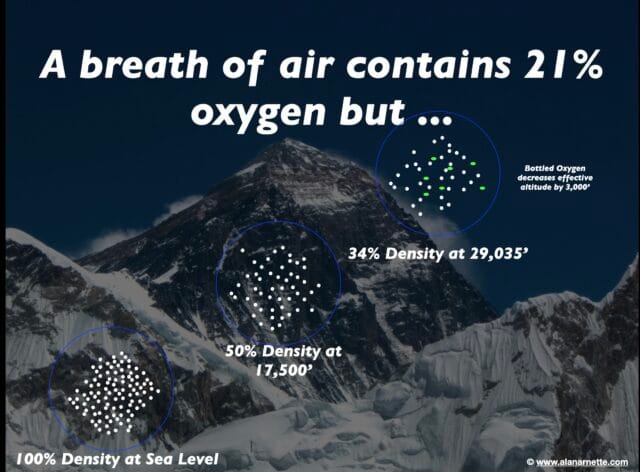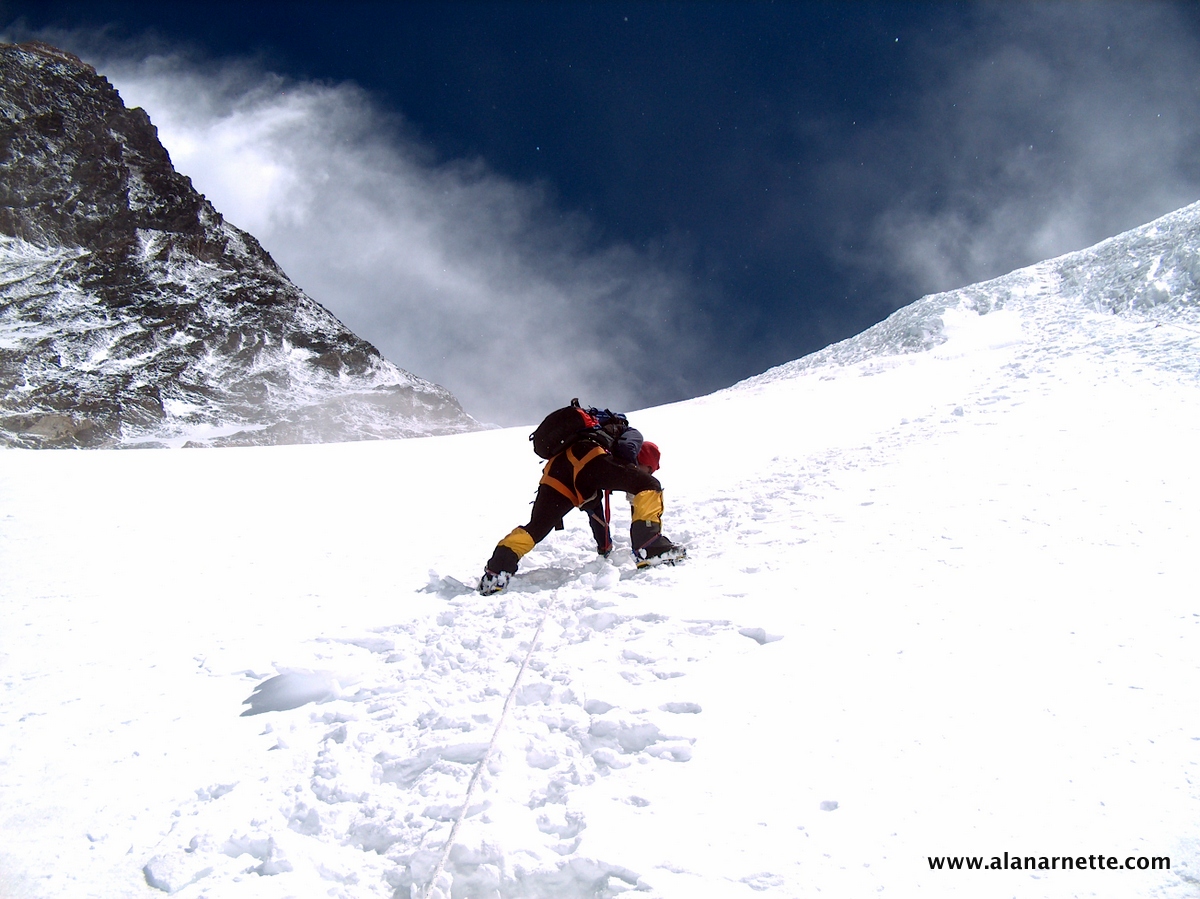It’s mid-season, and there is a lot of movement on Everest. The ropes are now at the South Col, and the rope team estimates tagging the summit around May 1, depending on the weather. Let’s look at acclimatization as teams maneuver to prepare their bodies for the summit push in a few weeks.
Big Picture
Teams are now scattered all over the Big Hill, working on their acclimatization, from EBC to Camp 2 just below the Lhotse Face. Adventure Consultants gave this update on their rotations:
Yesterday the climbing group braved a 12.30am breakfast then drifted into the darkness towards the icefall just after 1am. Prior to departure they held a brief ceremony at the lap chur – a small stone chorten where the monks held our Puja ceremony one week ago. By mid afternoon the team members were settled into Camp 1 around 5,900m where they will stay 2 nights to acclimatise before moving up the mountain to Camp 2. They’ll stay there a couple more nights and hopefully travel to the base of the Lhotse face before returning to Base Camp to rest.
The Art of Acclimatizing
acclimatize | əˈklʌɪmətʌɪz | (British also acclimatise) verb [no object] (often acclimatize to or be/become acclimatized to) become accustomed to a new climate or new conditions; adjust: it’s unknown whether people will acclimatize to increasingly warm weather. • technical respond physiologically or behaviourally to a change in conditions in the natural environment. ORIGIN early 19th century: from French acclimater ‘acclimatize’+ -ize.
There you have it; acclimatizing is the most critical element of safely summiting Everest. Few humans don’t need to acclimatize. Those who go to an Everest summit without spending a few nights above 6000 meters or higher are destined to return home empty or not return home at all.
It’s pretty easy to tell when you are suffering from altitude. You lack appetite; experience vomiting, headache, distorted vision, and general fatigue. But the trick is that “altitude sickness,” aka AMS symptoms, can vary in severity from person to person. Hence, it’s best to be evaluated by someone who has training in altitude sickness. But in any case, the only true treatment is to descend as quickly and safely as possible.
One of the standard tests to evaluate AMS is The Lake Louise Score, a scoring system of symptoms developed by experts at a conference in Lake Louise, Canada.

The physiological concept of acclimatization is simple, put your body at an altitude with less available oxygen than it had in previous days, and the body almost immediately begins to adjust.
Stay there for a while, preferably days, and the body reacts with significant changes in the blood chemistry. Some of the changes include:
- Faster breathing
- Heart rate and blood pressure increase
- less plasma (water) in the blood, so it becomes thicker
- An increased level of hematocrit, the red blood cells that carry oxygen to our muscles
- Increased urination in response to changes in the body’s acid/base balance
- Occasionally, mild swelling in hands, feet, and face
- Frequent awakenings and light sleep
This is how Everest legend Tom Hornbein, who was instrumental in the development of supplemental oxygen breathing systems, explained it to the American Lung Association:
The lower oxygen stimulates chemoreceptors that initiate an increase in breathing, resulting in a lowering of the partial pressure of CO2 and hence more alkaline blood pH. The kidneys begin to unload bicarbonate to compensate. Though this adaptation can take many days, up to 80% occurs just in the first 48 to 72 hours. There are many other physiologic changes going on, among them the stimulus of low oxygen to release the hormone, erythropoietin to stimulate more red blood cell production, a physiological and still acceptable form of blood doping that enhances endurance performance at low altitudes. Adaptive changes are not always good for one’s health. Some South American high-altitude residents can have what’s called chronic mountain sickness, resulting from too many red blood cells; their blood can be up to 84-85% red blood cells. The increased blood viscosity and sometimes associated pulmonary hypertension can result in right heart failure.
Studies have shown that red blood cells live for 120 days, but in general, your body will immediately begin to adjust to the current altitude. I’ve used the rule of thumb that you keep your acclimatization for as long as it took you to get it.
One of the best ways to adapt your body is the time-proven technique of climbing to 7,000 meters on the Lhotse Face, but, oh my, what a struggle. In fact, it is so difficult for many people they skip this step and start using supplemental oxygen from Camp 2 at 21,500 feet/6200 meters. While I disagree with the early use of Os, for style reasons, that’s my viewpoint only, and it’s becoming more popular each season.
Hypoxico Altitude Tents
I recently discussed the art of pre-acclimatizing at home using altitude tents on a Podcast with Lukas Furtenbach, a major mountaineering expedition guide company. He’s now a top supplier of supplemental oxygen systems to all teams climbing Everest. He partnered with Neil Greenwood of Summit Oxygen to create Everest Oxygen focusing on supplying supplemental oxygen to the mountaineering industry.
His Austrian-based Furtenbach Adventures offer global climbs, including most of the 8000-meter mountains, the Seven Summits, the Volcanic Seven Summits, and Ski Mountaineering. However, they have made a name for themselves with their “Flash Expeditions,” which takes only three weeks to climb Everest, compared to the classic style, which takes six to eight weeks.
One of his secrets is using an altitude tent, aka a hypoxia chamber, that acclimatizes his clients to 7,00 meters (23,000 feet) at home. This reduces the number of rotations required before the summit push and reduces the overall time spent at base camp. It’s not really a secret as anyone can rent or buy a tent, and other companies like Alpenglow out of Lake Tahoe, California, also specialize in rapid expeditions. However, Furtenback’s team out of Innsabruk closely monitors their client’s progress over the eight weeks they sleep in the tent, making daily changes to optimize the process.
Lukas is also investing in advanced technology to remotely monitor his customer’s health while climbing and evolving the oxygen regulator, the brains of the system that manages flow rates, to allow for an unprecedented eight liters per minute (lpm) flow. He only uses this high flow rate for short sections, for example, on the Hillary Step, to allow the climber to move faster. Otherwise, they run at today’s traditional two, four and six lpm rate.
Things continue to change on Everest in many ways making the mountain easier and more accessible to people, but dangers still exist and to underestimate it is a mistake.
Climb On!
Alan
Memories are Everything
Nepal RECORD Permit Update as of April 24, 2023
The permits for Everest are leveling out, albeit at a record of 454. The previous Everest record was 408 for the 2021 season of 408. Climbing permits have been issued for 1,009 climbers from 79 countries for 23 peaks. Looking at Everest only, China has the largest representation with 96 members, followed by the US at 87, India–at 40, -34, Canada-21, Russia-19, France-13, and Austria at 12. There are 38 countries represented by three or fewer climbers.
These permits have generated $5.4M in royalties for the government. Almost all of this revenue stays in Kathmandu, with some in various personal pockets and none to the Sherpas, porters, or other high-altitude workers. The Nepal Ministry of Tourism posted these foreign permit tally as of April 29, 2022:
- Everest: 454 on 39 teams
- Ama Dablam: 74 on 7 teams
- Annapurna I: 54 on 5 teams
- Dhaulagiri: 35 on 3 teams
- Himlung: 16 on 2 teams
- Khangchung: 42 on 4 teams
- Lhotse: 95 on 11 teams
- Makalu: 58 on 7 teams
- Manaslu: 15 on 4 teams
- Nuptse: 63 on 6 teams
The Podcast on alanarnette.com
You can listen to #everest2022 podcasts on Spotify, Apple Podcast, Google Podcasts, Pocket Casts, RadioPublic, Anchor, and more. Just search for “alan arnette” on your favorite podcast platform.
Summit Coach
If you dream of climbing mountains but are not sure how to start or reach your next level from a Colorado 14er to Rainier, Everest, or even K2, we can help. Summit Coach is a consulting service that helps aspiring climbers throughout the world achieve their goals through a personalized set of consulting services based on Alan Arnette’s 25 years of high altitude mountain experience, including summits of Everest, K2, and Manaslu, and 30 years as a business executive.




